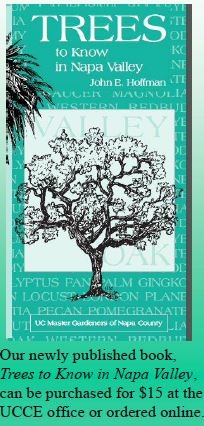
I don't even have to walk down the street to see striking trees. From the front porch of our home, I can look a block away and see what I now know to be a deodar cedar (Cedrusdeodara) that is easily 50 feet tall standing in front of a still taller Mexican fan palm (Washingtoniarobusta).
But my fascination with the trees of Napa didn't really begin until the day I spied what looked like spiky, green bowling balls beneath a tall, pine-like tree in Fuller Park.
“What's that funny-looking tree?”
“Bunya bunya.”
By this time, I'd followed my sister-in-law and wife into the University of California Master Gardener program. To help me identify the local trees, I was directed to Trees of Napa Valley written by John Hoffman, a respected local arborist and one of the original UC Napa County Master Gardeners.
This book spurred me to pay more attention to the trees around me. I read the section on the bunya bunya (Araucaria bidwillii) and learned that it, along with most of the trees in Fuller Park, was not native to the Napa area. This prehistoric tree hails from tropical Queensland, Australia, and appears to be little changed in appearance from fossilized remains dating back to the Mesozoic Era.
The large cones that so interested me can weigh up to 15 pounds. Seeds from the cones are larger than almonds and prized as a food source by Australian aborigines. Another fine specimen of the bunya bunya can be found not far from Fuller Park on the grounds of the Bali Hai Apartments in the 1700 block of Pine Street.
The dawn redwood (Metasequoiaglyptostroides) is another “living fossil” growing in Fuller Park. This remarkable tree was planted in the park by the Browns Valley Garden Club in 1954 and is reported to be the oldest tree of its species in California. A plaque at its base identifies it as being planted in memory of Herman J. Baade, a University of California farm advisor from 1914 to 1951.
John Hoffman writes of a tree thought to be extinct whose fossilized remains were found in many areas of the world. The fossil leaves and cones look much like those of the California Coast redwood (Sequoia sempervirens). In 1941 a Japanese botanist placed the fossils into genus Metasequoia.
Coincidentally, in the same year, a Chinese forester discovered a new type of deciduous conifer in a remote area of China. It was subsequently identified as the thought-to-be-extinct dawn redwood. Its seeds were propagated and seedlings were distributed to institutions all over the world, including Kew Gardens in London. That tree, planted in 1949, still stands today.
These are just two of the many interesting trees on view in Fuller Park. Purchased by the City of Napa in 1905, this former orchard and site of bygone playing fields has become a repository of trees from around the world.
The originalTrees of Napa Valley is no longer in print. However, the UC Master Gardeners of Napa County have recently published an updated version, Trees to Know in Napa Valley, with technical editor Bill Pramuk. A certified consulting arborist and long-time local columnist, Bill has an extensive knowledge of our local trees.
This book includes fold-out maps detailing tree walks in Fuller Park and downtown Napa, a collection of John Hoffman's original essays about some of the finest trees in the area, a tree-selection guide for home landscapes, and information about Napa's Registry of Significant Trees.
Guided tree walks in Fuller Park will be offered in the future by UC Master Gardeners of Napa County. For information on upcoming tree walks and other research-based information to aid the home gardener in Napa County please visit: http://ucanr.edu/ucmnapa/
Garden Tour: The UC Master Gardeners of Napa County invite you to their sixth garden tour, “Down the Garden Path”, on Sunday, September 13. On this self-guided educational tour you will see seven gardens by Master Gardeners in and around the City of Napa. These gardens illustrate how Napa County Master Gardeners use University of California research-based horticultural information to develop and maintain their own gardens.Tickets: $30 Advance/ $35 Day of Event. Purchase tickets at http://ucanr.edu/ucmgnapa. Or you can purchase tickets at the UC Master Gardener office (address below). For more information, call 707-253-4143.
Workshop: Join UC Master Gardeners of Napa County for a workshop on “Vegetable Vexations” on Saturday, September 12, from 9:30 a.m. to 11:30 a.m., at the University of California Cooperative Extension office, 1710 Soscol Avenue, Napa. Understanding pests and blights that affect your vegetables is key to managing them. Squash that doesn't grow, tomatoes with peculiar markings, artichokes full of earwigs, plants that fail to thrive—all these and more will be discussed. Bring your own vegetable vexations to show and tell, and see how integrated pest management techniques and Master Gardeners might help.Online registration (credit card only); Mail-in registration (cash or check only).
Master Gardeners are volunteers who help the University of California reach the gardening public with home gardening information. UC Master Gardeners of Napa County ( http://ucanr.org/ucmgnapa/) are available to answer gardening questions in person or by phone, Monday, Wednesday and Friday, 9 a.m. to Noon, at the U. C. Cooperative Extension office, 1710 Soscol Avenue, Suite 4, Napa, 707-253-4143, or from outside City of Napa toll-free at 877-279-3065. Or e-mail your garden questions by following the guidelines on our web site. Click on Napa, then on Have Garden Questions? Find us on Facebook under UC Master Gardeners of Napa County.